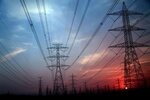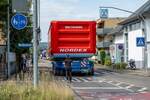A new system optimises electric transmission from offshore wind farms
This innovation, which the UC3M researchers have protected by a set of patents, allows the use of a diode rectifier station in the offshore platform of a high voltage direct current (HVDC) link. In this way the wind turbines alternating current (AC) can be easily converted into direct current (DC) for the HVDC transmission.
For this, they have developed a distributed control system which allows to synchronise and regulate the electrical voltage and frequency of the wind turbines of the offshore wind farm. This allows the transmission of energy to the general network through a HVDC link with a diode rectifier station. "It is less complicated, cheaper and more flexible than other current solutions", explains one of the authors of the patents, Santiago Arnaltes Gómez, head of the UC3M Power Control Group.
This new system synchronises the wind turbines without using any additional element, since it uses the wind turbines’ capacity to contribute to voltage and frequency control. One of key factors is the use of diode rectifier stations, which allow to reduce the cost of the offshore rectifier platform by up to 30 percent, according to some studies. "What we have managed to do is to provide the technical feasibility necessary in order to use this kind of rectifiers, since at the moment wind turbines still cannot work with them," explains another of the authors of the patent, José Luis Rodríguez Amenedo, from UC3M’s Department of Electrical Engineering.
The researchers have developed three patents in relation to this system, which they have validated by means of simulations, small-scale laboratory prototypes and proofs of concept. The next step is its commercialisation and industrialisation. "Our main clients would be large electricity companies that have the capacity to make these diode rectifier stations," said the researchers, who has been supported by the UC3M Science Park in the management and commercialisation of this new technological solution.
Globally, the integration of offshore wind farms into mainland electrical systems is currently being put forward as a way of reducing fossil fuel consumption and greenhouse gas emissions. Due to the fact that a significant proportion of the large offshore wind farms planned are located far from the coast, a connection using HVDC links (in direct current) is technically and economically more suitable than a HVAC transmission system (in alternating current).
- Source:
- Universidad Carlos III de Madrid
- Author:
- Press Office
- Link:
- www.uc3m.es/...
- Keywords:
- Universidad Carlos III de Madrid, Spain, offshore, wind farm, electric transmission, grid, optimization

























